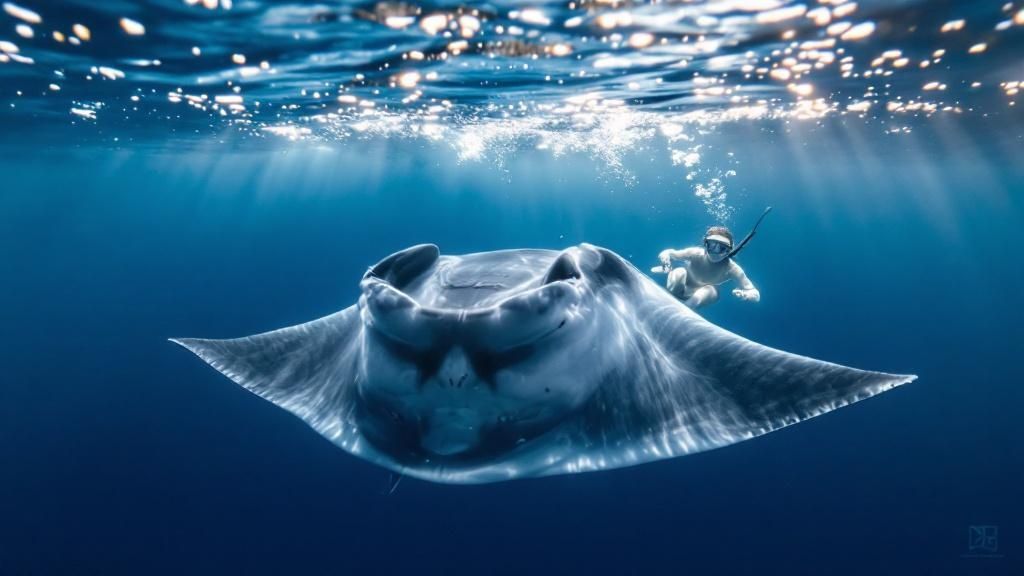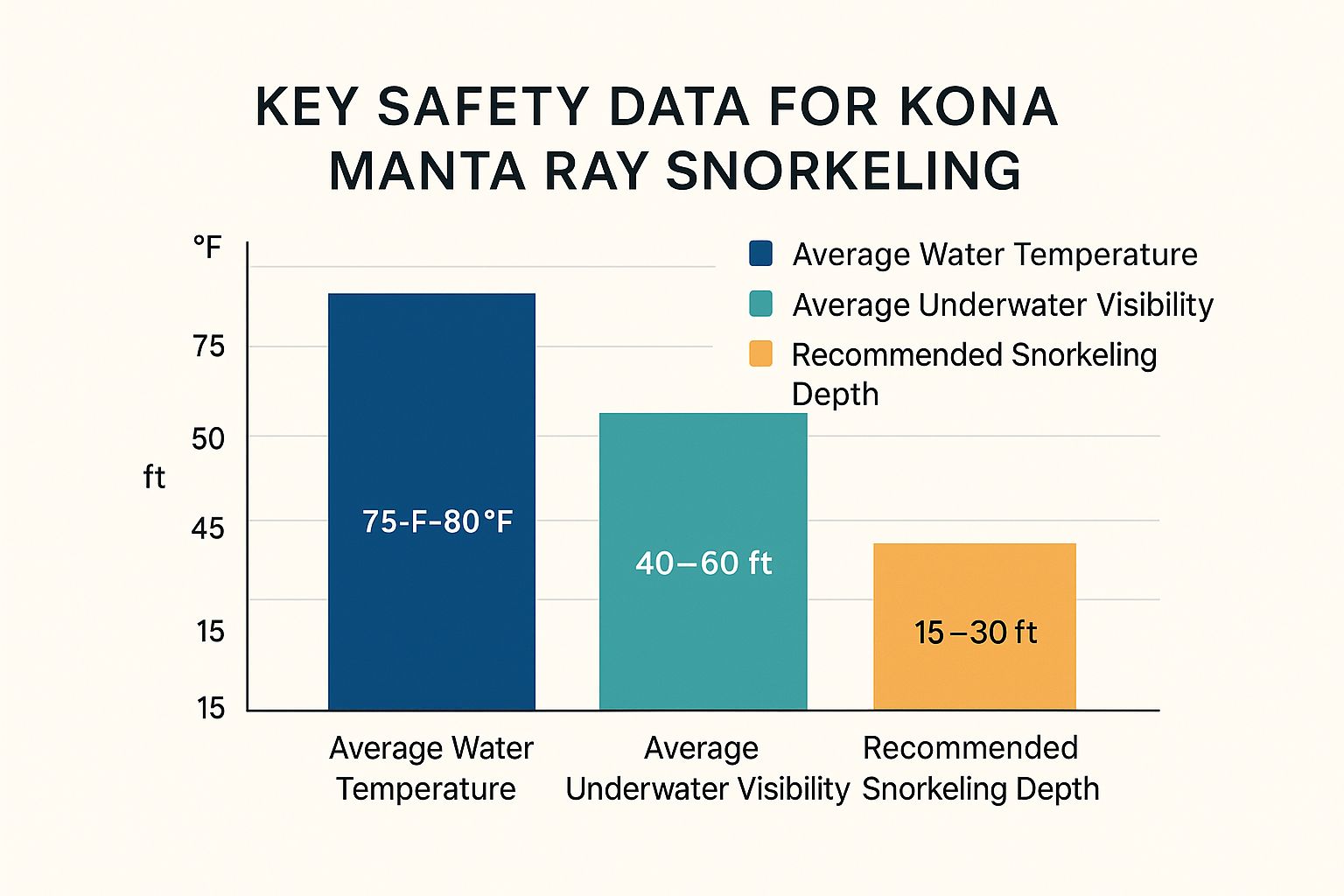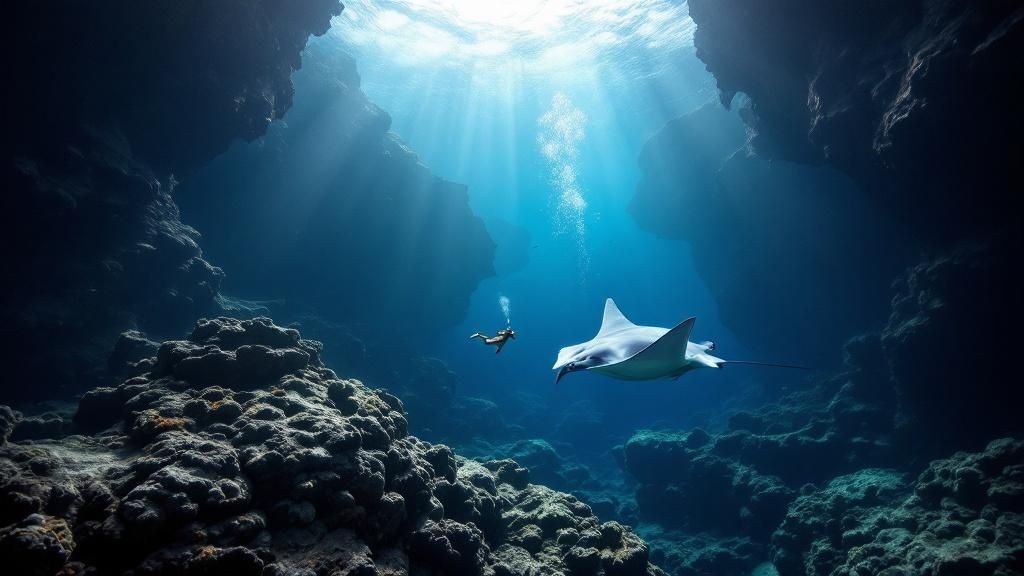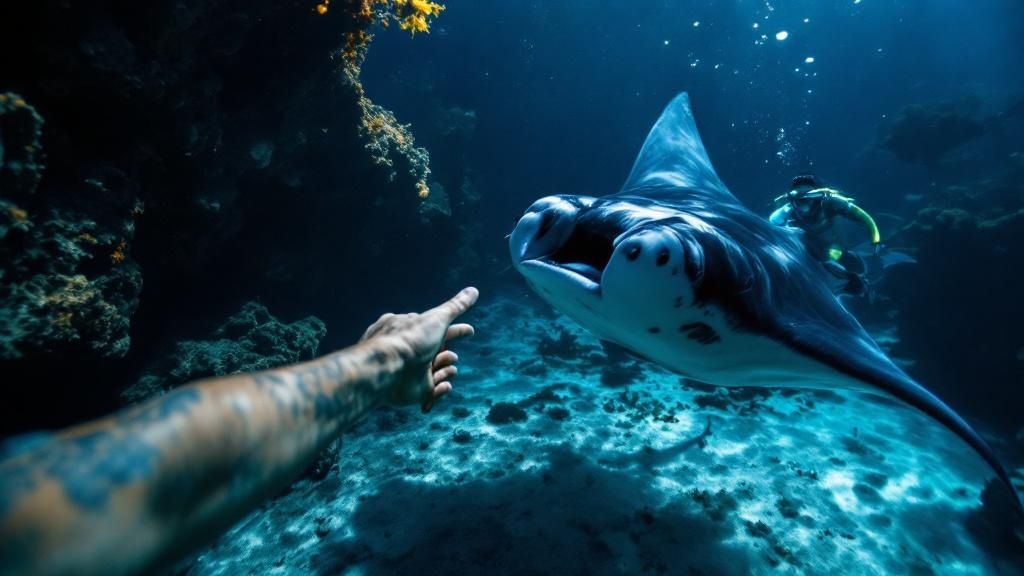Manta Ray Snorkel Kona: Your Complete Experience Guide
- Byron
- Jun 17
- 14 min read
Why Manta Ray Encounters Feel Like Magic

Many wildlife tours are a game of chance, but the manta ray snorkel kona is a special case. This isn't a fleeting migratory stop; Kona is the year-round home for a resident population of over 300 identified manta rays. Tour operators have come to understand their feeding habits, which makes sightings incredibly reliable. This consistency doesn't take away from the wildness of the moment; it just means you’re almost guaranteed a front-row seat to one of nature’s greatest shows.
The Ballet of the Gentle Giants
The magic works because of a very simple principle: light attracts plankton, and plankton attracts mantas. Tour boats position a floating light board in the water, which draws in clouds of microscopic plankton, creating a glowing buffet in the dark ocean. This glowing feast is an open invitation that the manta rays simply can't refuse.
They appear from the darkness and begin their feast. But this is no messy scramble for food; it's a beautifully choreographed underwater performance. They swoop and soar through the light, performing graceful barrel rolls with their giant mouths open to filter the water. These gentle giants, some with wingspans reaching 18 feet, move with an impossible elegance, often coming within inches of you. It's a peaceful, mesmerizing dance that you get to witness up close.
A Deeper Connection
What truly makes this encounter unforgettable is the feeling of connection. Manta rays are known for their intelligence, boasting the largest brain-to-body size ratio of any fish. They are curious by nature and often seem just as interested in observing you as you are in them.
As a manta ray glides past, it might turn and make direct eye contact. In that quiet moment, there's a sense of mutual awareness that bridges the gap between human and animal. It’s this combination—the starlit night, the silent underwater world, and the gentle intelligence of these amazing creatures—that leaves a lasting mark. You don't just watch the mantas from a distance; you share the water and a moment with them.
What Makes Kona The World's Manta Ray Capital
You can see manta rays in many places around the world, but Kona is different. The secret to its fame isn't just luck—it’s consistency. A unique combination of the Big Island's geology and ocean currents has created a near-perfect setup, making it the most reliable place on the planet to meet these gentle giants.
The Perfect Recipe: Geography And Ocean Currents
It all starts with the Big Island's volcanic origins. Beneath the waves, the steep, submerged slopes of ancient volcanoes act like giant ramps. Deep ocean currents, cold and packed with nutrients from the abyss, flow toward the island and are pushed upward along these slopes.
This natural process is called upwelling. Think of it as an underwater conveyor belt, lifting a feast of nutrients from the dark, deep ocean into the sunny, shallow waters right off the Kona coast.
The magic doesn't stop there. The shape of the coastline, with its protective coves and bays, traps this nutrient-rich water. Instead of being washed back out to sea, it creates a concentrated, super-charged soup of life right where the tours operate.
A Predictable Plankton Buffet
All those nutrients act like a powerful fertilizer for phytoplankton, the tiny marine plants that are the foundation of the ocean's food chain. This kicks off a massive and consistent plankton bloom, creating a thick, delicious soup that manta rays find absolutely irresistible.
This isn't just a good guess; it's proven by research. Between 2009 and 2014, scientists carefully tracked manta ray sightings and movements between the main snorkel sites. Their findings confirmed that the mantas follow predictable patterns, showing up for dinner at these specific spots every night. This is why the manta ray snorkel kona adventure has such a high success rate—the buffet is reliably open for business. Explore detailed manta ray sighting statistics.
Because the food is always here, Kona supports a large resident manta ray population. These aren't just visitors passing through; they live here all year because they never need to leave. Researchers have identified over 300 individual manta rays in the area, each recognized by the unique pattern of spots on its belly, which works just like a human fingerprint.
Knowing this backstory makes the experience even more special. When you slip into the water, you're not just a spectator. You are witnessing a timeless feeding ritual that is only possible because of this rare and perfect meeting of land and sea. It’s this incredible natural engine that makes Kona a truly world-class destination for marine life encounters. Read also: Why the Manta Ray Night Snorkel Is the Ultimate Adventure in Kona.
Planning Your Perfect Night Encounter
A truly unforgettable manta ray adventure starts long before you dip a toe in the ocean. While the goal is to see these gentle giants, the difference between a good trip and a great one comes down to smart planning. Getting the timing right, choosing the best tour, and knowing what to expect are the keys to an amazing manta ray snorkel kona experience.
Choosing The Right Time
You can find manta rays in Kona’s waters all year, but the conditions for seeing them change with the seasons. The best time to go is generally from late spring to early fall (April to October). During these months, the ocean is typically calmer with clearer visibility, making it a perfect window for snorkelers of all skill levels. Winter can bring bigger swells and a higher chance of tour cancellations due to rough seas.
Beyond the time of year, think about the moon cycle. A new moon creates the darkest sky, which makes your tour boat’s underwater lights the star of the show. These lights are like a giant neon sign for plankton, and a concentrated food source often leads to more active manta rays. A full moon, while beautiful, can sometimes spread out the ambient light, making the plankton a little less focused.
Understanding Local Conditions
The ocean environment in Kona is remarkably consistent, which is great news for snorkelers. To help you know what to expect, this table breaks down the conditions throughout the year.
Seasonal Manta Ray Snorkeling Conditions in Kona
Comparison of weather conditions, visibility, and manta ray activity throughout the year
Season | Water Temperature | Visibility | Manta Activity | Weather Conditions | Best For |
|---|---|---|---|---|---|
Summer (May-Oct) | 77-80°F (25-27°C) | Excellent (80-100+ ft) | High & Consistent | Calm seas, sunny days | Everyone, especially first-timers and families |
Winter (Nov-Apr) | 74-76°F (23-24°C) | Good to Variable (60-80 ft) | High but can be weather-dependent | Chance of larger swells and rain | Experienced swimmers or travelers with flexible schedules |
As you can see, the water stays warm and the manta activity is reliable year-round. The biggest variable is the ocean swell, which is why booking during the calmer summer months is often recommended if your schedule allows.

Vetting Your Tour Operator
Your tour operator can make or break your experience, and the cheapest option isn't always the best. Look for companies that prioritize quality and safety. Smaller group sizes almost always lead to a better, more personal encounter with the mantas. Check that the guides are lifeguard-certified and passionate about marine life. A company’s dedication to conservation is another great sign you’re in good hands.
Before you book, be sure to ask a few key questions:
What is your guest-to-guide ratio?
Can you explain your safety procedures for a night snorkel?
What is your policy if the tour is canceled or if we don't see mantas?
Getting clear answers will help you find a responsible and professional crew. For more insights, you can explore our complete guide to this night adventure.
A Note on Wild Animals
Finally, it’s important to remember that you're visiting wild animals in their natural home. While Kona tours have an incredible sighting success rate of over 90%, there's no guarantee. It's always a good idea to book your tour for early in your vacation. That way, if bad weather forces a cancellation, you have a built-in buffer to reschedule your once-in-a-lifetime snorkel.
Getting Ready For Your Underwater Adventure

Mastering Your Gear Before You Go
While your tour operator will provide the necessary equipment, taking a moment to check your gear can make a massive difference. This isn't about looking good; it's all about function. Think of your snorkel mask as your personal window to the underwater show. A leaky, foggy mask is like trying to watch a movie through a smudged screen—it constantly pulls you out of the magical moment.
Many seasoned snorkelers prefer to bring their own mask and snorkel that they know fits perfectly. If you use the gear provided, test the fit on the boat before you even get near the water. The mask should form a light seal on your face without feeling too tight. Your wetsuit is your own personal climate control. Even though Kona's water is warm, you’ll be floating in place for about 45 minutes. A snug wetsuit, typically 3mm, stops a slow chill from creeping in and distracting you.
Here are a few simple steps to get your gear ready:
Test Your Mask: Before putting on the strap, press the mask to your face and gently inhale through your nose. If it stays in place for a few seconds, you have a solid seal.
Prevent Fog: Ask your guide for a bit of baby shampoo or defog solution. A thin layer rubbed on the inside of the lens will keep your view crystal clear.
Wetsuit Comfort: Your wetsuit should feel like a second skin—snug but not restrictive. You should be able to breathe and move easily.
Fins: You won't be doing any serious swimming, but fins help you move to and from the viewing area. Make sure they fit comfortably and don't pinch your feet.
Building Confidence for the Night Snorkel
Beyond your equipment, feeling mentally and physically ready is just as important. You don't need to be an Olympic swimmer, but you do need to be comfortable floating in water over your head. The tour is structured for maximum safety; you will hold onto a large, custom light board that floats on the surface. This board not only attracts plankton for the mantas but also gives you a stable point of contact.
Every tour kicks off with a detailed safety briefing. Pay close attention. Your guides will walk you through everything, from how to enter the water to simple hand signals for communicating after dark. They are experts at managing groups and keeping a watchful eye on everyone. Trusting their process is the first step to calming any pre-snorkel nerves. Their number one goal is to provide a safe, positive, and unforgettable encounter for everyone on board.
The Magic Unfolds: Your Manta Ray Encounter
The boat ride out from the harbor is a peaceful experience, with the night sky stretching above you. A quiet excitement builds as the engine cuts, and the only sound is the gentle lapping of waves. This is the moment you transition from the world above to the incredible spectacle waiting just below the surface.
The Light Show Begins
Your guide will help you ease into the warm Pacific waters. You'll be given a specially designed light board to hold onto, which serves as a floating beacon in the dark ocean. This board is more than just a floatation device; it's the main event's centerpiece. Its bright lights shine down, acting like a powerful magnet for clouds of microscopic plankton.
It’s similar to turning on a porch light on a summer night and watching moths gather. Out here, this glowing buffet is an irresistible dinner bell for Kona's gentle giants. The stage is now set for their grand entrance.
An Underwater Ballet
At first, you’ll only see the shimmering cloud of plankton dancing in the light. Then, a large shadow will separate itself from the deep blue. It’s a truly breathtaking moment. A giant manta ray, with a wingspan that can reach up to 16 feet, glides effortlessly into the light.
Soon, more will arrive, and they'll begin a mesmerizing underwater performance. They swoop and soar with their mouths wide open, performing graceful barrel rolls just inches beneath you to filter as much plankton-rich water as possible. They move with a silent, fluid grace that seems impossible for their immense size.
Any nervousness you might have had will quickly dissolve into overwhelming awe. This experience is incredibly popular, attracting roughly 80,000 participants annually. This is largely due to an amazing success rate of 80% to 90%, meaning nearly every tour witnesses this magic. This reliability has made the manta snorkel a can't-miss activity. Discover more about why this tour is so unforgettable.
You become a silent observer in their world, watching a feeding ritual that has occurred here for generations. It’s a powerful reminder of the vibrant life teeming just beneath the waves.
Your guides ensure the entire experience is safe for both you and the mantas. Before you get in the water, it helps to be familiar with the basics. These Snorkeling Tips for Beginners can help you feel even more prepared. The most important rule is simple: look, but don’t touch. By floating peacefully and holding onto the light board, you allow the mantas to feel safe, which is why they come so incredibly close. This passive observation is the foundation of an ethical and successful manta ray snorkel kona encounter.
This is more than a tour; it’s an immersive experience that often changes how people view the ocean. Witnessing the intelligence and gentleness of these creatures firsthand fosters a deep appreciation for marine conservation. You leave not just with photos, but with a powerful memory and a newfound respect for the ocean's gentle giants. Check out our ultimate guide on this top Hawaii experience.
Choosing Operators Who Deliver Exceptional Experiences

The incredible popularity of the manta ray snorkel in Kona means you have many tour companies to choose from, but the quality of the experience can vary wildly. Choosing the right operator is the single most important decision you'll make. It’s the difference between a magical, life-changing memory and a chaotic, forgettable boat ride. A poor choice can leave you feeling like just another number, so picking wisely is key.
The Small Group Advantage
Imagine trying to admire a famous painting in a museum. Would you rather be in a small, private group or crammed shoulder-to-shoulder with a huge crowd? The manta ray snorkel is no different. An intimate, small-group tour creates a much better experience for everyone.
Fewer people in the water means less splashing and commotion, which results in a calmer environment for both you and the manta rays. A smaller guest-to-guide ratio also guarantees you’ll get more personal attention, have your questions answered, and feel much safer throughout the adventure.
What to Look for in a Quality Operator
Beyond group size, a few key things separate the great tours from the merely good ones. The best operators invest in the entire experience, from the moment you check in to long after you’ve returned to shore.
Expert Guides: Your guides should be more than just boat crew; they should be passionate marine naturalists who are also lifeguard-certified. They turn a great trip into an amazing one by sharing fascinating insights about manta ray biology, behavior, and the local ecosystem.
Top-Notch Safety & Gear: Look for operators who provide a clear, detailed safety briefing and well-maintained equipment. A clean wetsuit that fits properly and a high-quality, anti-fog mask are essential for your comfort and enjoyment.
Commitment to Conservation: The best companies are dedicated stewards of the ocean. They will strictly enforce the “look, don’t touch” rule and teach you how to observe the mantas respectfully without altering their natural behavior.
The very thing that makes Kona a world-class manta destination—the reliable food source that attracts them—also creates a challenge: overcrowding. With numerous boats at each site, the water can feel congested. A 2010 social survey revealed that 78% of participants felt crowded by other tour boats, and 82% felt crowded by fellow snorkelers. These numbers highlight why choosing an operator who carefully manages group size is so important. You can discover more insights from the social survey here.
To help you vet potential tour companies, we've created a simple comparison guide. Use these points to evaluate operators and find one that matches your expectations.
Manta Ray Tour Operator Comparison Guide
Key factors to evaluate when choosing a manta ray snorkel tour operator in Kona
Factor | What to Look For | Red Flags | Questions to Ask |
|---|---|---|---|
Group Size & Ratio | Small groups (typically under 18 guests). A low guest-to-guide ratio (e.g., 8:1). | Large boats packed with dozens of people. Vague answers about maximum capacity. | "What is the maximum number of guests you take out on a single tour?" |
Crew Expertise | Guides are certified marine naturalists and lifeguards. They are passionate and knowledgeable. | The crew seems disengaged or acts only as boat drivers. The briefing is rushed or uninformative. | "What are your guides' qualifications? Are they marine naturalists?" |
Safety & Equipment | A comprehensive safety briefing before entering the water. Clean, well-maintained gear (wetsuits, masks, snorkels). | Worn-out, dirty, or ill-fitting gear. A nonexistent or rushed safety briefing. | "Can you describe your safety procedures? Is all gear included and in good condition?" |
Conservation Ethos | Strict "no-touching" policies. Education on how to interact with mantas respectfully. | Lack of conservation messaging. Guides or guests touching marine life. | "What are your specific rules for interacting with the manta rays?" |
This table gives you a clear framework for finding a tour that is not only fun but also safe and respectful to the incredible animals you’re there to see.
So, how do you find these top-tier operators? Start by reading reviews with a critical eye. Look past the simple "we saw mantas!" comments and dig for details about the crew's knowledge, the quality of the gear, and the overall feel of the group size. Vague answers to the questions above are a major red flag. By doing a little homework, you can ensure your trip is an exceptional and memorable encounter with Kona's majestic manta rays. For a head start, check out our guide on the best manta ray snorkel tours in Kona.
Extending Your Kona Ocean Adventure
Your incredible manta ray encounter doesn’t have to be the end of your trip; in fact, it can be just the beginning. Think of it as opening the door to Kona's massive underwater world. The same unique conditions that create a perfect plankton buffet for the mantas also support an amazing variety of other sea creatures. This one swim can spark a desire to see everything else this Hawaiian ecosystem has to offer.
Complementary Marine Adventures
With a new appreciation for the ocean, you can easily plan a few more days dedicated to Kona’s other amazing marine encounters. Each activity shows you a different side of this special environment.
Turtle Town Snorkeling: Head to famous spots you can walk right into, like Kahaluʻu Bay Beach Park. This bay is a popular hangout for the Hawaiian green sea turtle, or honu, so you’re almost certain to have a respectful sighting.
Dolphin & Reef Exploration: Take a morning boat tour to see energetic spinner dolphins jumping and spinning in their natural home. These trips often include a stop at a beautiful snorkel spot like Kealakekua Bay, which has some of Hawaii's most colorful coral reefs.
Seasonal Whale Watching: If your visit falls between December and April, seeing a humpback whale leap from the water is an experience every bit as powerful as swimming with the mantas.
Cultural and Conservation Connections
In Hawaiian culture, ocean animals carry deep spiritual weight. The manta ray, known as hahalua, is seen by some families as a powerful ancestral spirit, or ʻaumakua, that acts as a respected guardian.
Knowing this cultural background adds a much deeper meaning to your manta ray snorkel kona tour. It changes it from a simple wildlife viewing into a chance to connect with a living, sacred tradition. This connection often moves people to become champions for the ocean. You can join a local beach cleanup, report your manta sightings to help scientists, or just tell others what you learned about watching wildlife responsibly. You can learn more in our article about what makes this Hawaii's best adventure. Your adventure becomes a part of a bigger story of preserving these fragile marine habitats.
Ready to start your own Kona ocean story? The journey begins with that first magical night in the water. Book your unforgettable Manta Ray Night Snorkel tour with us today and unlock the door to the Big Island's incredible underwater world.
Comments